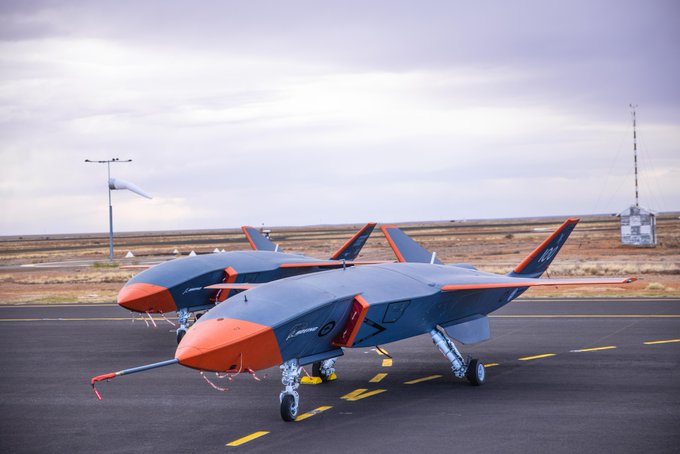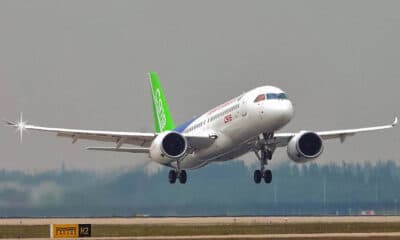Aerospace
First made-in-china large commercial aircraft , C919 rolled off production line.

The Commercial Aircraft Corp of China (Comac) said on Monday it had rolled out its C919 narrow body jet, which is meant to rival similar models from Airbus Group and Boeing Co.
State television also showed footage of the aircraft rolling off the assembly line in Comac’s Shanghai factory. In a statement, the company said it had already received 517 orders for the aircraft mainly from domestic firms.
About C919
“C919″is the short form of trunk liner code for “COMAC919”. COMAC is the acronym of the Commercial Aircraft Corporation of China, Ltd. The letter “C” is the first letter of both “COMAC” and “China”. It indicates that this trunk liner program is the will of China and her people. It is a short-medium range commercial trunk liner that can claim indigenous intellectual property. Its all-economy class layout entails 168 seats, and the hybrid class layout 156 seats. The basic version is designed to cover a range of 4,075 km, while the enhanced version can stretch to 5,555 km. Such designs may satisfy the operating demands for different routes. Its economic life is designed to be 90,000 flying hours/30 calendar years.
Features
Safety:
The design, development, and airworthiness examination of the airplane are completely based on international civil aviation rules and regulations and airworthiness standards.
Economics:
Fuel consumption and direct operating cost per seat per kilometer are lower than those of similar existing airplanes.
Comfort:
Broader cabins and wider seats plus advanced system technology to improve comfort.
Environmentally friendly:
New engine to meet noise and pollutant discharge requirements.
Product family:
Covering basic version, extended version, shortened version, cargo version, special version and corporate version.
The Comac C919 is a family of 158-174 seat narrow-body twin-engine jet airliners built by the Commercial Aircraft Corporation of China (Comac). It is the largest commercial airliner designed and built in China since the defunct Shanghai Y-10. Its first flight is expected to take place in end of 2015, with first deliveries scheduled for late 2018.
Dimensions
Dimensions of the C919 are very similar to the Airbus A320, possibly to allow for a common pallet to be used. Its fuselage will be 3.96 metres (13 feet) wide, and 4.166 metres (13 feet, 8 inches) high, producing a cross-section of 12.915 square metres (139 square feet). The wingspan will be 33.6 metres (110 feet, 3 inches), or 35.4 metres (116 feet, 3 inches) if winglets are included.
Payload
Payload will be 20.4 metric tonnes. Its cruise speed will be Mach 0.785 and it will have a maximum altitude of 12,100 metres (39,800 feet).
capacity
There will be two variants. The standard version will have a range of 4,075 km (2,200nm), with the extended-range version able to fly 5,555 km (3,000nm).
According to a film shown by Comac at the 2010 Zhuhai Airshow, the company plans to build six different models of the aircraft: a base passenger aircraft with 168 seats, as well as stretched and shrunk passenger versions, business jet and freighter models, and a type designated only as “special” .
Price tag
The Comac C919 is intended to be a new entrant in the commercial airliner market specifically targeted at low-cost airlines. Fuel price increases are especially damaging to the low-cost flying model, leading these airlines to renew their fleets frequently. This ensures optimal fuel performance and reliability across a single-type fleet. Direct competitor – Boeing 737 unit cost of US$ 78.3-108.3 million, means that target price for this airplane should be lower. The Airbus A320 has a wider price range, from US$71.9 million to US$120.5 million. The Comac developers have not announced a price tag for each plane, although based on industry speculation current orders for 2012 could be worth more than US$26 billion. This with 2012 orders for 380 examples, lead to projected average price of about $68 million.
Total no of orders 517 (as of 2015)
At the 2015 Paris Air Show, Ping An Leasing signed a letter of intent for 50 C919s.This deals makes the Shanghai-based Chinese lessor one of Comac’s largest customers. In addition to Ping An Leasing, Puren Group also signed a letters of intent for seven C919s and seven ARJ21s, intended for the start-up Puren Airlines.Also during that time Nepal Airlines and Air India was interested in acquiring 2-3 to replace older aircraft.
Design and assembly of the aircraft done in Shanghai, using foreign-made jet engines and avionics. However, China has expressed its desire to produce a domestically made engine for the C919. The center wing box, outer wing box, wing panels, flaps and ailerons are planned to be built in Xi’an, China. The center fuselage sections are planned to be built in Hongdu, China.The airframe will be made largely of aluminium alloy, while the center wing box also makes use of carbonfiber composites.
CFM International will supply a version of the LEAP engine, the LEAP-1C, to power the aircraft. The engine’s nacelle, thrust reverser and exhaust system will be provided by Nexcelle, with such features as an advanced inlet configuration, the extensive use of composites and acoustic treatment and an electrically operated thrust reverser. Michelin will supply Air X radial tyres.
Dimensions
Dimensions of the C919 are very similar to the Airbus A320, possibly to allow for a common pallet to be used. Its fuselage will be 3.96 metres (13 feet) wide, and 4.166 metres (13 feet, 8 inches) high, producing a cross-section of 12.915 square metres (139 square feet). The wingspan will be 33.6 metres (110 feet, 3 inches), or 35.4 metres (116 feet, 3 inches) if winglets are included.
Payload
Payload will be 20.4 metric tonnes. Its cruise speed will be Mach 0.785 and it will have a maximum altitude of 12,100 metres (39,800 feet).
capacity
There will be two variants. The standard version will have a range of 4,075 km (2,200nm), with the extended-range version able to fly 5,555 km (3,000nm).
According to a film shown by Comac at the 2010 Zhuhai Airshow, the company plans to build six different models of the aircraft: a base passenger aircraft with 168 seats, as well as stretched and shrunk passenger versions, business jet and freighter models, and a type designated only as “special”.
Liked it ..?
Share with your friends and family

Aerospace
Top 10 world’s best military drones in 2024

In an age defined by rapid technological advancement and strategic military innovation, the role of unmanned aerial vehicles, commonly known as drones, has become increasingly pivotal on the modern battlefield.
As we step into 2024, the global landscape of military drones continues to evolve, with nations investing heavily in cutting-edge technologies to maintain superiority in reconnaissance, surveillance, and combat operations.
Join us as we delve into the top 10 military drones that are shaping the future of warfare, showcasing their capabilities and impact on the ever-changing theater of conflict.
1. Boeing MQ-28 Ghost Bat :This aircraft represents a cutting-edge advancement in unmanned combat aerial vehicles, currently under development by Boeing Australia. As a Loyal Wingman class aircraft, it is engineered to seamlessly integrate with existing military aircraft, enhancing and extending airborne missions through its stealth capabilities and multirole functionality. With an impressive range surpassing 2,000 nautical miles and a combat radius of 900 miles, it promises to revolutionize aerial operations. Anticipated to join the ranks of the RAAF in 2024-25, these unmanned platforms herald a new era in military aviation.
2.The Bayraktar TB2: stands as a formidable medium-altitude long-endurance (MALE) unmanned combat aerial vehicle, crafted by the Turkish company Baykar. Renowned for its prowess, Bayraktar drones have found their way into the arsenals of numerous nations worldwide, seeing action in various conflicts including the Russian invasion of Ukraine and the Tigray War. Featuring a sleek blended wing body design complemented by an inverted V-tail structure, the TB2 platform exemplifies innovation in aerial technology. With an approximate price tag of 5 million US dollars per unit, it represents a significant investment in defense capabilities.
3. Bayraktar Kızılelma: A cutting-edge project by Turkish defense company Baykar, introduces a single-engine, low-observable, carrier-capable, jet-powered unmanned combat aerial vehicle. It boasts a sleek, supersonic airframe designed for reduced radar cross-section (RCS) and is outfitted with an advanced AESA radar system. Its operational combat radius spans 500 nautical miles. Weighing in at a maximum takeoff weight (MTOW) of 6,000 kilograms (13,200 lb), it reserves 1,500 kg for payload capacity. Already, two prototypes have been manufactured, with plans for operational deployment expected by 2025.
4. XQ-58 Valkyrie: is a cutting-edge unmanned flying machine (drone) built for the U.S. Air Force. Designed by Kratos Defense, this high-tech aircraft is like a silent wingman, following a manned fighter jet and carrying out various missions. These missions could include scouting ahead for dangers, providing extra firepower, or even acting as a decoy to protect the manned aircraft. It boasts a maximum range extending approximately 3,000 miles, with a hefty maximum launch weight capped at 6,500 pounds. This figure includes the capacity to accommodate up to 600 pounds within its internal payload bay and an additional 600 pounds beneath its wings.
5.TAI Aksungur: is a heavyweight drone built for the Turkish Armed Forces. Designed by Turkish Aerospace Industries, it boasts an impressive wingspan of 12 meters (39 feet) and can carry a significantly larger payload than its predecessor. The Aksungur’s central fuselage, housed beneath the wings, is the brain of the operation. The range of this drone extends to 6,500 kilometers and payload capacity is 750 kg. It carries all the avionics, camera systems, and sensors the drone needs to function. An additional camera mounted on the chin provides a clear view directly below the aircraft.
6.Hongdu GJ-11: It is Sharp Sword is a marvel of Chinese aviation technology. This unmanned aerial vehicle (UAV), also known as a drone, is designed for stealth and long-range combat missions. The Sharp Sword’s tailless flying wing design makes it difficult to detect on radar. Internally, it houses two weapon bays, allowing it to carry a variety of armaments for air-to-surface strikes.
While the exact engine remains unknown, reported specifications boast an impressive range of 2,485 miles (4,000 kilometers) and accommodates internal weapons bays capable of carrying payloads of up to 2,000 kilograms (4,400 lbs). This combination of stealth, firepower, and range makes the GJ-11 a significant player in modern aerial warfare.
7.Dassault Neuron: is a pioneering unmanned combat aerial vehicle (UCAV) built through a collaborative effort by European nations. This high-tech drone serves as a technological demonstrator, paving the way for future autonomous combat aircraft.
Designed for stealth and independent operation, the nEUROn is built to handle the toughest combat environments. With a sleek design measuring 10 meters long and 12 meters wide, it has an estimated unit cost of €25 million if a production version were built. The nEUROn’s demonstrator model weighs approximately 5 tons and showcases the potential for future European-built combat drones. It has capability to transport two laser-guided 250 kg bombs, each housed in its own weapon bay.
8.The Sukhoi S-70 Okhotnik-B: also known as Hunter-B, is a formidable unmanned combat aerial vehicle (UCAV) under development by Russia’s Sukhoi company. Designed to strike fear into the hearts of enemies, this high-tech drone is built for stealthy operation.
The Okhotnik-B boasts a flying-wing design, a favorite technique for minimizing radar detection. Its construction incorporates composite materials and special stealth coatings to further reduce its radar signature.Powering this aerial predator is an AL-31 turbojet engine, allowing it to reach estimated speeds of 1,000 kilometers per hour with a range of 6,000 kilometers.
9.The Northrop Grumman X-47B: is a groundbreaking unmanned combat aerial vehicle (UCAV) designed for launching and landing on aircraft carriers. This American marvel, developed by Northrop Grumman, is a tailless jet with a unique blended-wing-body design. This design helps it cut through the air efficiently. It can operate semi-autonomously, meaning it can fly pre-programmed missions with some human oversight.The X-47B can refuel in the air, extending its range for even longer missions at sea. The X-47B drone boasts an approximate range of 2,100 nautical miles.
10.CAIG Wing Loong II:
The Chengdu GJ-2, also known as the Wing Loong II, is a powerful unmanned aerial vehicle (UAV) built for long-range strikes. Developed by the Chengdu Aircraft Industry Group, this drone can be controlled remotely or fly autonomously using pre-programmed missions.
An upgrade from its predecessor, the Wing Loong I, II boasts a larger body and wider wingspan, allowing it to carry an impressive payload. This drone can pack a punch with up to 480 kilograms of laser-guided bombs and missiles. The manufacturer even claims it has the potential to carry air-to-air weaponry, making it a versatile threat in the skies.It can carry a maximum payload of 400 kilograms.
Aerospace
India is set to build a central command for the Air Traffic Control system, called ISHAN

India’s air traffic growth has led to increased responsibilities for air traffic control. The Airports Authority of India (AAI) is considering centralizing air traffic control for aircraft, dividing the country into four regions. The goal is to consolidate India’s segmented airspace into a single entity to improve air traffic management (ATM) efficiency, safety, and smoothness.
Recently, the AAI invited expressions of interest to develop a detailed project report for the Indian Single Sky Harmonized Air Traffic Management (ISHAN) initiative in Nagpur. Under this plan, air traffic controllers in Nagpur would handle domestic flights flying above 25,000 feet, eliminating the need for coordination among controllers in different regions.
For domestic regional flights operating above 25,000 feet, control would shift to the central command in Nagpur. This consolidation aims to enhance airline operations, increase flight handling capacity, and reduce congestion and flight times for passengers.
Currently, the AAI provides ATM services over Indian airspace and adjoining oceanic areas, covering over 2.8 million square nautical miles. This airspace is divided into four flight information regions (FIRs) in Delhi, Mumbai, Kolkata, and Chennai, along with a sub-FIR in Guwahati.
FIRs are responsible for providing air traffic services, including weather information, visibility, and search and rescue assistance. The proposed unification under the ISHAN initiative aligns with the projected growth of the aviation industry, which anticipates a doubling of domestic passenger traffic by 2030.
Aerospace
Does AirAsia show interest in Comac aircraft in the future?

Tony Fernandes, CEO of Capital A, operating as AirAsia Group, recently paid a visit to the facilities of COMAC on April 2, 2024, and was thoroughly impressed by what he witnessed.
C919 already securing nearly 1000 orders
COMAC, known for its homegrown aircraft, has launched two promising jets: the ARJ21 and the C919 aircraft. Both aircraft are gaining popularity in the Chinese market, with the C919 already securing nearly 1000 orders from various airlines.
Fernandes expressed his admiration for COMAC’s achievements in aircraft manufacturing, acknowledging the immense challenge it entails. His visit underscored the realization that AirAsia now has a viable third option when it comes to selecting aircraft for its fleet.
During his tour, Fernandes was delighted by the innovation and technology evident in COMAC’s aircraft production and the company’s commitment to long-term partnerships.
He noted that many Western companies have shifted away from prioritizing loyalty and customer service, opting instead for short-term gains and a narrow definition of success.
Last month, COMAC embarked on an international tour, showcasing demonstration flights to neighboring countries, particularly Indonesia and Malaysia. Fernandes believes that the positive impression left by COMAC during his visit opens up new opportunities for collaboration.
Fernandes emphasized COMAC’s remarkable achievements
The shared values of loyalty, customer service, and long-term vision align closely with AirAsia’s ethos, making collaboration with COMAC appealing. With a focus on innovation and excellence, both companies stand to benefit from a partnership grounded in trust and a shared commitment to success.
Indonesia and China have already collaborated in validating and maintaining the airworthiness of the ARJ21 aircraft, indicating a solid foundation for future partnerships.
In his statement, Fernandes emphasized COMAC’s remarkable achievements and genuine desire for long-term partnership, highlighting the absence of ego and a genuine willingness to succeed together. He marveled at COMAC’s fully automated, AI-driven factory, a testament to their dedication to innovation and efficiency.
Fernandes criticized Western firms for prioritizing short-term gains over loyalty, customer service, and long-term strategy, emphasizing the importance of understanding customers’ needs and collaborating to achieve success.


























